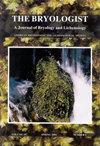毛菖蒲科;地衣子囊菌)北美东部阿巴拉契亚山脉南部特有的一种不寻常的新种
IF 1.5
4区 生物学
Q4 PLANT SCIENCES
引用次数: 0
摘要
摘要根据美国东部阿巴拉契亚山脉南部的材料,沙多尼亚被描述为新的科学。该物种似乎是该地区的特有物种,主要局限于针叶树的树皮。它在该地区濒危的高海拔云杉冷杉林中尤为丰富和频繁。该新物种与同类物种的区别在于其皮质习性,微小的乳晕状铊,带有乳晕,乳晕爆发成能溶解乳晕并呈现鳞片状外壳的女贞子体,具棕色质质的暗褐黑色尖端古猿,以及具有大的、鼠形子囊孢子的单孔海鞘。它也与Pilocarpaceae的其他属,特别是Calopadia进行了比较。盘形Lopadium,一个表面上相似的物种,也与新物种进行了比较,并提供了该物种的照片以及北美洲东部的分布图。本文章由计算机程序翻译,如有差异,请以英文原文为准。
Schadonia saulskellyana (Pilocarpaceae; Lichenized Ascomycetes) an unusual new species endemic to the southern Appalachian Mountains of eastern North America
Abstract. Schadonia saulskellyana is described as new to science based on material from the southern Appalachian Mountains in the eastern United States. The species appears to be endemic to the region and mostly restricted to the bark of conifers. It is particularly abundant and frequent in the imperiled high-elevation spruce-fir forests of the region. The new species is distinguished from its congeners by its corticolous habit, minutely areolate thallus with areoles that erupt into soralia which dissolve the areoles and give the appearance of a leprose crust, epruinose, dark brown-black apothecia with a brown hypothecium, and monosporous asci with large, muriform ascospores. It is also compared with other genera of Pilocarpaceae, particularly Calopadia. Lopadium disciforme, a superficially similar species is also compared to the new species and photographs, as well as a distribution map for eastern North America, are provided for that species.
求助全文
通过发布文献求助,成功后即可免费获取论文全文。
去求助
来源期刊

Bryologist
生物-植物科学
CiteScore
2.40
自引率
11.10%
发文量
40
审稿时长
>12 weeks
期刊介绍:
The Bryologist is an international journal devoted to all aspects of bryology and lichenology, and we welcome reviews, research papers and short communications from all members of American Bryological and Lichenological Society (ABLS). We also publish lists of current literature, book reviews and news items about members and event. All back issues of the journal are maintained electronically. The first issue of The Bryologist was published in 1898, with the formation of the Society.
Author instructions are available from the journal website and the manuscript submission site, each of which is listed at the ABLS.org website.
All submissions to the journal are subject to at least two peer reviews, and both the reviews and the identities of reviewers are treated confidentially. Reviewers are asked to acknowledge possible conflicts of interest and to provide strictly objective assessments of the suitability and scholarly merit of the submissions under review.
 求助内容:
求助内容: 应助结果提醒方式:
应助结果提醒方式:


